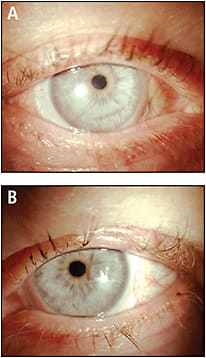Contact Lens Design & Materials
Sclerals Can Be Notch-tastic!
BY DAVID L. KADING, OD, FAAO

A middle-aged Hispanic male who had keratoconus had exhausted all other contact lens modalities, and scleral lenses were the only specialty lenses that could provide adequate vision. However, due to severe, bilateral pingueculae, he suffered from significant irritation and redness during and after scleral lens wear.
Because the edges of his lenses nasally and temporally rested on an unstable landing surface due to the elevations, he was prone to getting debris under the lenses. His chronic inflammation also caused watering and mucus external to the lenses that blurred his vision. This patient benefited greatly from notched lenses.
When any type of contact lens rests partially on an area of elevation, it can cause decentering and other fitting complications. Notches can be beveled into scleral lenses to accommodate an irregular eye shape or obstacle.
In particular, notches are useful for some patients who have areas of elevation due to glaucoma shunts or significant pingueculae. When a non-notched scleral lens is fit on an eye that has areas of substantial elevation under the landing zone of the lens, it is usually problematic (Figure 1). Because scleral lenses are manufactured in rigid materials, the edges of the lens dig into the elevated areas, rather than fitting smoothly over them. Blockage of a filtering bleb or compression and irritation of pingueculae are common adverse effects in this case.

Figure 1. Prior to getting a notch, the lens does not fit properly on the eye.
The Perfect Notch
Creating an optimal notch requires working closely with your specialty contact lens lab (Figures 2 and 3). Sharing an anterior segment photo of the eye with the lab is often helpful in optimizing the lens design.

Figure 2. One method of notch fitting is to mark the lenses in office and send either the marked lenses or a photo of them to the laboratory.

Figure 3. Patient with notches on the lenses: OD (A) and OS (B).
Other useful ways to design a custom notched lens include keeping several notched lenses in the office for a fitting template. Alternately, an intact existing scleral trial lens can be placed on the eye and marked directly to outline the obstacle.
The size of the notch relative to the lens size must be considered. A very large or deep notch may cause the scleral lens to develop an air bubble or not remain stable on the eye. When fitting a scleral lens that is 15.8mm or greater in diameter, it is best to ensure that the notch does not come inside of the limbus. CLS
Dr. Kading owns the Specialty Dry Eye and Contact Lens Center in Seattle. He is the co-owner of Optometric Insights with Dr. Mile Brujic. He has received honoraria for consulting, performing research, speaking, and/or writing from Alcon Laboratories, Allergan, Bausch + Lomb, Biotissue, Contamac, Essilor, Nicox, Oculus, RPS Detectors, TearScience, Valley Contax, and ZeaVision. Follow him on Twitter @davekading.



